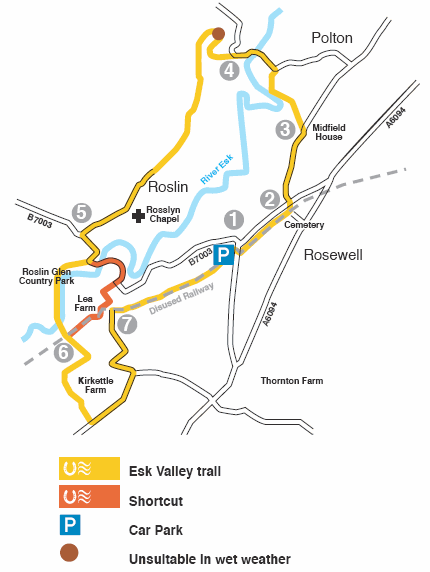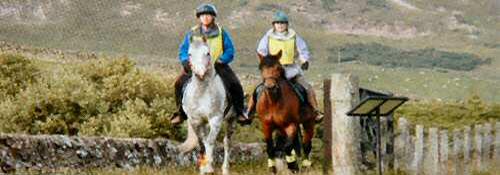Esk Valley Trail
| Distance: | 8 miles |
| Pace: | Walk and trot |
| Parking: | Small car park at Rosewell at junction of A6094 and B7003. There is an alternative near the cemetery. |
| Please note: | If you are organising a group ride please remember to contact the landowner as a matter of courtesy and for parking arrangements. |

Route Description
This horse trail takes you through some of the most historic areas of Midlothian and follows both public roads and off road tracks. The route starts and ends on a disused railway, part of the old Edinburgh to Peebles railway track that was closed in 1969.
After a short road stretch past the entrance to Hawthornden Castle, you enter an old Roman track. It takes you down into the Esk valley, part of which is a SSS1 (Site of Special Scientific Interest). From the middle ages to the mid 20th century this valley was industrialised, with paper mills, carpet factories and other factories. You can see the remains of old buildings, and a water mill as you cross the bridge at the weir in Roslin Glen.
The woodland is very ancient mixed deciduous woodland and if you are lucky, you might see roe deer, otter, heron, dippers, kingfishers, kestrels and buzzards. Halfway along this route you may see the canopy over the roof of Rosslyn Chapel, well worth a separate visit. Leaving the valley by a series of horse steps, there is a short but pretty loop through farmland and then back on to the railway line again. Look out for the old Rosslyn Castle station sign picked out in white stones as you finish your ride.
Picnic tables and a horse tie-up rail have been installed at Rosslyn Castle station, and other minor landscaping work here should be completed by the spring.
Current Restrictions
The trail passes one short steep rough section and a flight of horse steps. Avoid the section marked with a brown dot on the map in wet weather. B7003 is steep, narrow, winding and may be busy at times.
Please note that after heavy rain the ground at The Cast and through Bilston Burn Woods can be in poor condition and is best avoided until the ground dries up.




